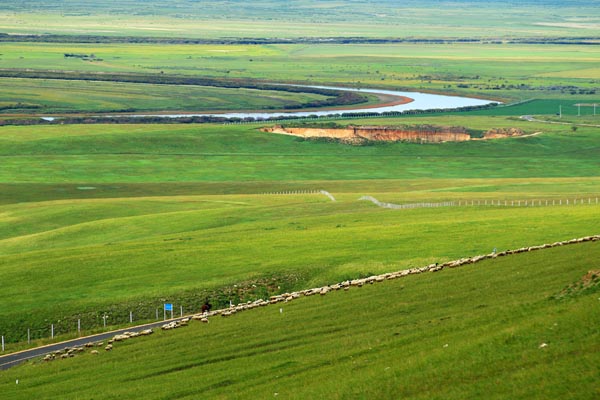
From the People's Daily app.
And this is Story in the Story.
China has at least 10,000 conservation areas, about 18 percent of the total land area, consisting of a wide range of forests, grasslands, wetlands, and deserts.
Diplomats and representatives from 13 countries and international organizations praised China’s efforts in conserving forestry and grassland ecology visiting North China’s Inner Mongolia Autonomous Region.
Inner Mongolia in northern China spreads across 26 million hectares of forest and 88 million hectares of grassland, ranking first in the country in terms of ecological environment.
“Ecological conservation and rehabilitation are the common challenges for mankind all around the globe and cooperation of countries especially the developing ones are needed to overcome these challenges,” said Meng Xianlin, Director General of Department of International Cooperation.
Today's Story in the Story looks at ecological conservationism and how China is preserving its grasslands located within the country's northern Inner Mongolia region.

Hulunbuir in the Inner Mongolia autonomous region boasts spans of grasslands. (Photo: CHINA DAILY)
As a leading expert in her field, Xin Xiaoping quite literally has a natural passion for the grasslands of the Inner Mongolia autonomous region, and she loves nothing more than to travel out to the plains to take samples to study back at her laboratory.
Using a sampling square called a quadrat-a simple 1-square-meter frame-which she lays on the ground at a chosen spot, Xin takes samples of all the plants found within it, taking care to place each species of plant in a separate envelope.
"By using the quadrat, I gain a deeper understanding of the grasslands. Having visited nearly every region of grassland in China, I realize my passion for them is in my blood," said 49-year-old Xin.
A researcher and doctoral supervisor at the Institute of Agricultural Resources and Regional Planninng at the Chinese Academy of Agricultural Sciences, Xin is also the head of the national field station at the Inner Mongolia Grassland Ecosystem Research Station in Hulunbuir.
She was given the 2018 Technology Innovation Award by China Central Television and Chinese Academy of Sciences in January for her research on grassland ecology. And now, after spending three decades studying them, Xin's colleagues refer to her as "the daughter of the grasslands.”
She recalls how at the age of 11 her father first took her to the grasslands in the Gannan Tibetan autonomous prefecture, Gansu Province, where she was stunned by the world that unfolded in front of her.

The wetland conservation in Ergun City, Hulun Buir in North China’s Inner Mongolia Autonomous Region (Photo: GT)
In 1998, Xin was recruited by Li Bo, an academician at the Chinese Academy of Sciences, to join his grassland ecology remote sensing team to help build an observation and research station in Hulunbuir.
Xin was keen to start the work, but Li suddenly died six months into the project. After taking three months to overcome her sorrow, Xin decided to finish Li's vision to build the observation and research station.
She was named executive deputy head of the station in 2005, the first female out of all the executives staffing the 53 wild scientific stations across China.
Xin developed a software application in 2000 to show herdsmen what kind of plants grow in what area, and she continued collecting data and adding to it. In 2015, Xin and her team published a book summarizing guidelines and methods to cultivate pastures in China.
Xin's team launched an app aimed at helping herdsmen around China to manage their pastures and predict their harvest. Using the remote sensing techniques to observe the ecosystems of the grasslands and combining the data collected by her team of researchers, the app models growth patterns of the grass.
"We used to monitor and manage the situation using remote sensing . Now with these formulas, we can predict the future and even make future plans based on them, which can raise the income of herdsmen in China," said Xin.
She is looking for her successor to take up her work at the station.
"No matter who is the head of the organization, it should continue to operate efficiently. That's my hope for the station," said Xin.
(Produced by Nancy Yan Xu, Lance Crayon, Brian Lowe and Chelle Wenqian Zeng. Music by: bensound.com. Text from Global Times and China Daily.)


